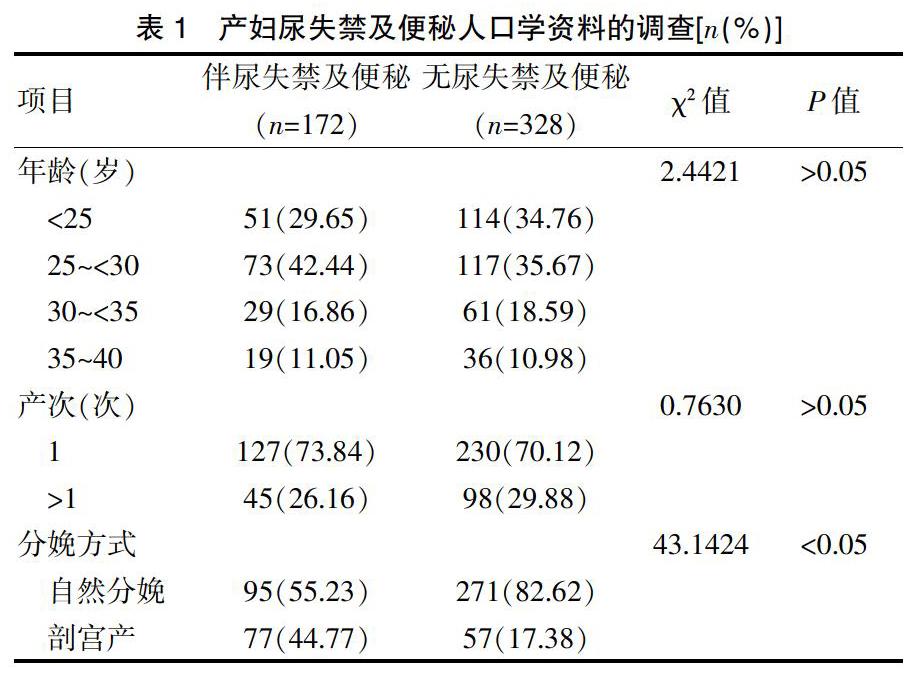我院产妇产后尿失禁及便秘发病情况及认知状况的调查研究
2020-10-09万满红连任华支美芳
万满红 连任华 支美芳


[摘要]目的 調查产后尿失禁及便秘的患病率,分析产妇对产后尿失禁及便秘的认知状况。方法 采用便利抽样法,选取我院2019年1~3月收治的500名产妇作为研究对象,统计产后尿失禁及便秘的患病率,调查产妇尿失禁及便秘的认知情况。结果 500名产妇中,仅有产后尿失禁者97例(19.40%),产后便秘者46例(9.20%),产后尿失禁伴便秘者29例(5.80%),总患病率为34.40%(172/500)。伴尿失禁及便秘者的年龄、产次与无尿失禁及便秘者比较,差异无统计学意义(P>0.05)。伴尿失禁及便秘者的分娩方式与无尿失禁及便秘者比较,差异有统计学意义(P<0.05)。调查结果显示,500名产妇的尿失禁及便秘认知情况均较低,伴尿失禁及便秘产妇的认知情况与无尿失禁及便秘产妇比较,差异无统计学意义(P>0.05)。结论 产后尿失禁及便秘的发病率较高,分娩方式可能对产后尿失禁及便秘的发生有影响,产妇对尿失禁及便秘的认知情况较差,需加强健康宣教。
[关键词]产后尿失禁;产后便秘;患病率;调查研究
[中图分类号] R714.6 [文献标识码] A [文章编号] 1674-4721(2020)8(c)-0165-03
[Abstract] Objective To investigate the prevalence of postpartum urinary incontinence and constipation, and analyze the maternal cognition of postpartum urinary incontinence and constipation. Methods Using the convenience sampling method, 500 parturients admitted to our hospital from January to March 2019 were selected as the research objects. The prevalence rate of postpartum urinary incontinence and constipation was counted, and the recognition of urinary incontinence and constipation among parturients was investigated. Results In the 500 parturients, 97 cases (19.40%) had only postpartum urinary incontinence, 46 cases (9.20%) had only postpartum constipation, and 29 cases (5.80%) had postpartum urinary incontinence with constipation, the total prevalence rate was 34.40% (172/500). There were no significant differences in age, labor times between the patients with urinary incontinence and constipation and those without urinary incontinence and constipation (P>0.05). There was significant difference in delivery mode between the patients with urinary incontinence and constipation and those without urinary incontinence and constipation (P<0.05). The investigation results showed that the cognitive status of urinary incontinence and constipation in 500 parturients was lower. There was no significant difference in the cognitive status of parturients with urinary incontinence and constipation and those without urinary incontinence and constipation (P>0.05). Conclusion The incidence of postpartum urinary incontinence and constipation is higher, the mode of delivery may affect the occurrence of postpartum urinary incontinence and constipation, and puerperas′awareness of urinary incontinence and constipation is poor, so health education should be strengthened.
[Key words] Postpartum urinary incontinence; Postpartum constipation; Prevalence rate; Investigation and study
